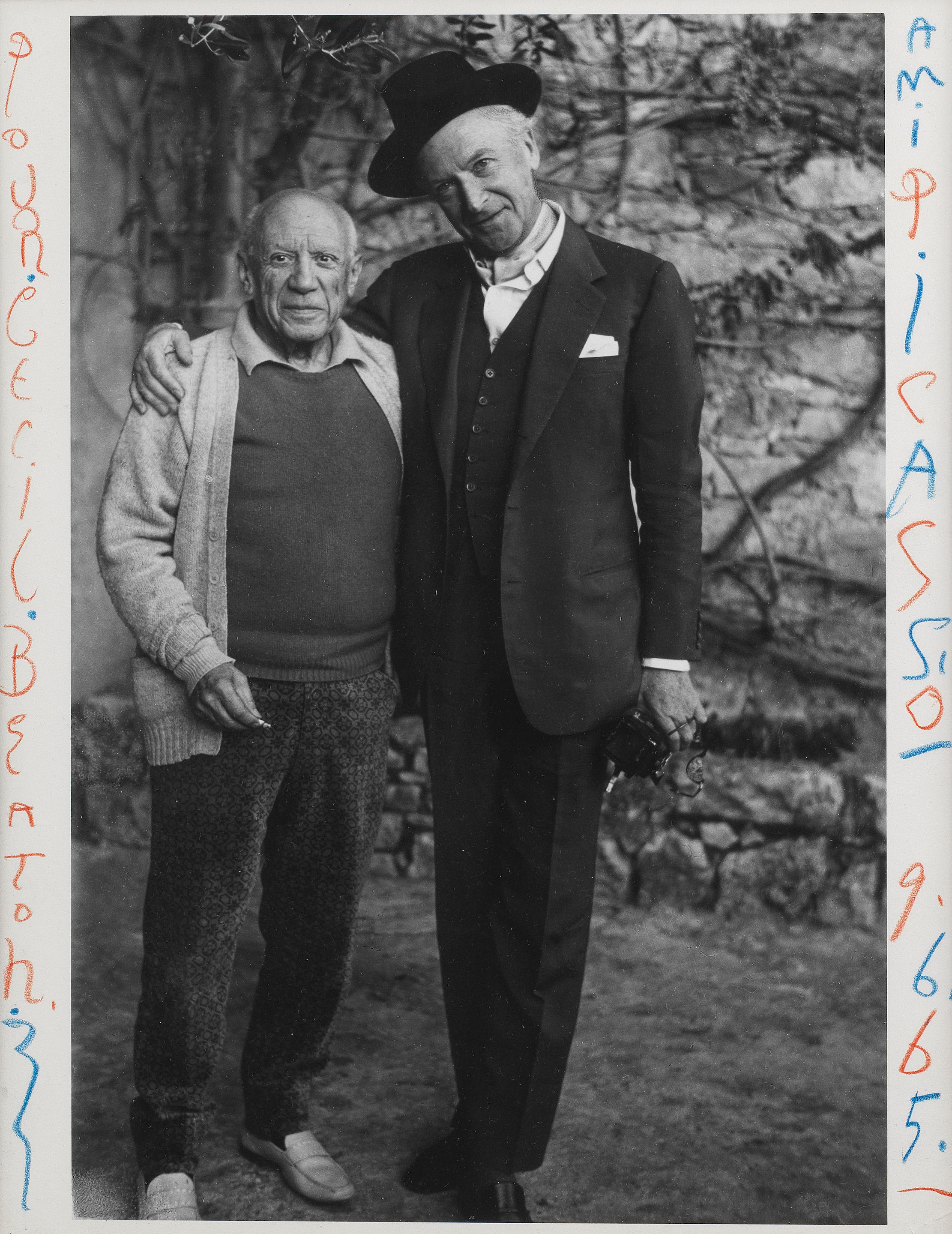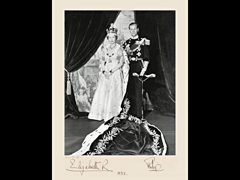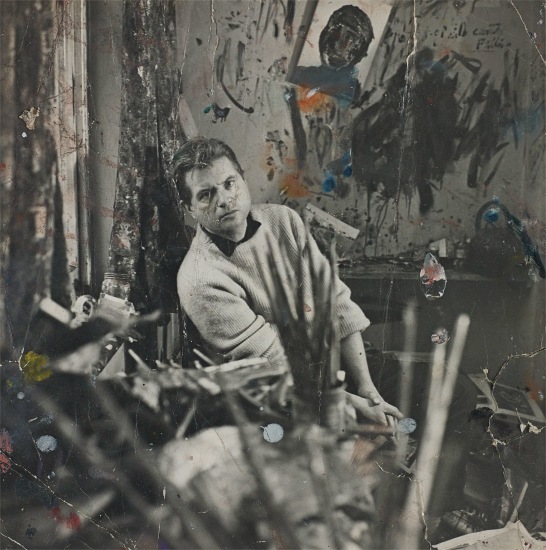Cecil Beaton Follow The Blitz/Western Campanile of St. Paul’s seen through Victorian shop-front 1940 Gelatin silver print. 8 1/2 x 8 in. (21.6 x 20.3 cm) Credit stamp, titled and variously annotated in unidentified hands in pencil and ink on the verso.
Provenance 'The Saturday Book' Picture Library (the contents of which were dispersed at auction in the early 1970s) Christie's, London, 6 May 1993, lot 98 Literature Beaton, Air of Glory, A Wartime Scrapbook , p. 76, there titled Apocalypse Beaton, Theatre of War , p. 18, there titled St. Paul's Cathedral after a heavy incendiary raid, London Beaton, The Years Between, Diaries: 1939-44 , p. 64 Catalogue Essay One of the most prolific photographic and literary diarists of the 20th century, Cecil Beaton created a vivid record of the destruction of London during World War II. Beaton was best known for his fashion photography and elegant studio portraiture, but his wartime work for the Ministry of Information and the Royal Air Force showed him to be a photojournalist of real talent and feeling. Roaming the decimated streets of London with his camera, Beaton found a poignant symbol of Britain’s resilience in the twin towers of St. Paul’s cathedral “rising mysteriously from the splintered masonry and smoke” ( The Years Between, Diaries: 1939-44 , p. 59). It has recently been discovered that Charles Sheeler used the shape of this stone archway for his 1941 painting Nativity . While Sheeler regularly used his own photographs as source material for his paintings, his use of photographs by others is less documented. For Nativity , a painting in the Magic Realist style, Sheeler replicated the overall shape and textural details of the arch. Sheeler likely encountered the arch in a photograph by Hans Wild in LIFE magazine, taken on the same day and from the same vantage point as Beaton’s. Read More Artist Bio Cecil Beaton British • 1904 - 1980 Follow Cecil Beaton was a highly celebrated British photographer who is perhaps best known for taking portraits of the colorful celebrities who composed the fashionable society of early-mid twentieth century London, all of whom were within his social circle. According to an autobiographical account, Cecil Beaton's relationship with photography began as a boy when he fell in love with picture postcards of the Edwardian theater actress Miss Lily Elsie. He took up photography at a young age, using his sisters Nancy and Baba as his primary subjects. Initially, Beaton sought to emulate pictures he saw in fashion magazines, especially the soft-focus technique used by Baron Adolphe de Meyer. In 1929 he moved to New York after signing a contract with American Vogue . Throughout the 1930s Beaton traveled extensively as a portrait photographer, spending time in Hollywood amongst the glitter and glamour of Hollywood film stars. When the Second World War began and focus turned towards its dangers and devastations, Queen Elizabeth II commissioned Beaton to document the ravages of the German blitz. Following the War, in addition to taking photographs, in the late 1950s into the 1960s Beaton was involved in film as a stage and costume designer. During this time, he designed the costume and set for the stage version of My Fair Lady (New York, 1956; London, 1958) and the film Gigi (1958). View More Works
Cecil Beaton Follow The Blitz/Western Campanile of St. Paul’s seen through Victorian shop-front 1940 Gelatin silver print. 8 1/2 x 8 in. (21.6 x 20.3 cm) Credit stamp, titled and variously annotated in unidentified hands in pencil and ink on the verso.
Provenance 'The Saturday Book' Picture Library (the contents of which were dispersed at auction in the early 1970s) Christie's, London, 6 May 1993, lot 98 Literature Beaton, Air of Glory, A Wartime Scrapbook , p. 76, there titled Apocalypse Beaton, Theatre of War , p. 18, there titled St. Paul's Cathedral after a heavy incendiary raid, London Beaton, The Years Between, Diaries: 1939-44 , p. 64 Catalogue Essay One of the most prolific photographic and literary diarists of the 20th century, Cecil Beaton created a vivid record of the destruction of London during World War II. Beaton was best known for his fashion photography and elegant studio portraiture, but his wartime work for the Ministry of Information and the Royal Air Force showed him to be a photojournalist of real talent and feeling. Roaming the decimated streets of London with his camera, Beaton found a poignant symbol of Britain’s resilience in the twin towers of St. Paul’s cathedral “rising mysteriously from the splintered masonry and smoke” ( The Years Between, Diaries: 1939-44 , p. 59). It has recently been discovered that Charles Sheeler used the shape of this stone archway for his 1941 painting Nativity . While Sheeler regularly used his own photographs as source material for his paintings, his use of photographs by others is less documented. For Nativity , a painting in the Magic Realist style, Sheeler replicated the overall shape and textural details of the arch. Sheeler likely encountered the arch in a photograph by Hans Wild in LIFE magazine, taken on the same day and from the same vantage point as Beaton’s. Read More Artist Bio Cecil Beaton British • 1904 - 1980 Follow Cecil Beaton was a highly celebrated British photographer who is perhaps best known for taking portraits of the colorful celebrities who composed the fashionable society of early-mid twentieth century London, all of whom were within his social circle. According to an autobiographical account, Cecil Beaton's relationship with photography began as a boy when he fell in love with picture postcards of the Edwardian theater actress Miss Lily Elsie. He took up photography at a young age, using his sisters Nancy and Baba as his primary subjects. Initially, Beaton sought to emulate pictures he saw in fashion magazines, especially the soft-focus technique used by Baron Adolphe de Meyer. In 1929 he moved to New York after signing a contract with American Vogue . Throughout the 1930s Beaton traveled extensively as a portrait photographer, spending time in Hollywood amongst the glitter and glamour of Hollywood film stars. When the Second World War began and focus turned towards its dangers and devastations, Queen Elizabeth II commissioned Beaton to document the ravages of the German blitz. Following the War, in addition to taking photographs, in the late 1950s into the 1960s Beaton was involved in film as a stage and costume designer. During this time, he designed the costume and set for the stage version of My Fair Lady (New York, 1956; London, 1958) and the film Gigi (1958). View More Works
.jpg)
.jpg)
.jpg)
.jpg)









.jpg)

Testen Sie LotSearch und seine Premium-Features 7 Tage - ohne Kosten!
Lassen Sie sich automatisch über neue Objekte in kommenden Auktionen benachrichtigen.
Suchauftrag anlegen